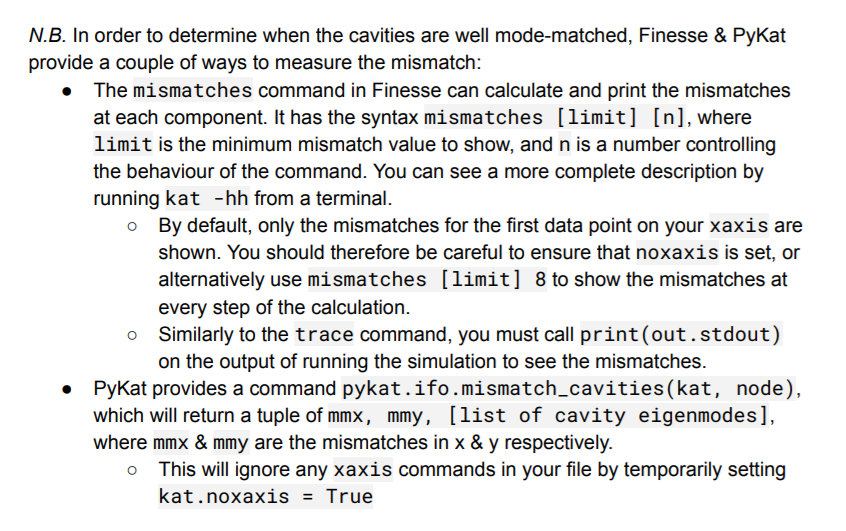In the fourth task of task 2, We are not able to implement methods to measure the mismatch. Also, the references do not have these commands.

The output obtained by the second method is hard to understand.

IUCAA Finesse Workshop and Hackathon 2019/20
Introducing Finesse for Gravitational-Wave Detector Design and Characterisation
In the fourth task of task 2, We are not able to implement methods to measure the mismatch. Also, the references do not have these commands.

The output obtained by the second method is hard to understand.

You must be logged in to post a comment.
Hi Anil!
As stated in the text, the output of that pykat command will be a *tuple* containing the mismatches in x, mismatches in y, and a list of eigenmodes. You’re see all of those outputs at the moment. If you just want to see the mismatches you should do something like
mmx, mmy, eigenmodes = pykat.ifo.mismatch_cavities(kat4,”n2″)and then pick one to display/print. E.g.
display(mmx*100)will give a nice-looking table of the mismatches in x as percentages. You can also get the average mismatch in both axis, i.e. (mmx+mmy)/2
Alternatively, using the
mismatchesFinesse command works very much liketrace 2, which you encountered in part 6 of the Gaussian mentoring notebook. If you have trouble getting that version to work, please make another post with the code you are trying to run so we can debug it more easily.Thanks Anna.
(Edit: ah, it looks like Anna answered this before me! I’ll keep my reply here so that there are two explanations!)
Hi Anil, it looks like in the second case (the
mismatch_cavitiescommand) the output is being printed in raw form, which is a little bit messy. It would probably be useful for you to assign the output from this function into three variables, then print them individually, like so:The
print(cav_eigenmodes)output is a little bit messy but contains useful information about your cavity beams. As you can see, it is a list (denoted by square brackets) of tuples (round brackets) containing three values: the cavity name (e.g. “FPcav1”), the cavity eigenmode in the x-plane, and the cavity eigenmode in the y-plane. The eigenmodes are theFor the first suggested approach – using the “mismatches” command – I can’t quite tell what the problem you are having is. Note that this command must be added to your Finesse input file, e.g. by using
kat.parse(...). Then, once you run the file without = kat.run, you have toprint(out.stdout)to see the results from “mismatches”. Alternatively you could run the input file directly with Finesse, not Pykat, and you would see the output printed to your terminal/command prompt. If you are having some other issue with this command then please let me know!Thank you Sean.